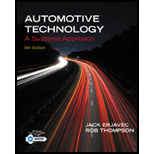
Automotive Technology: A Systems Approach (MindTap Course List)
6th Edition
ISBN: 9781133612315
Author: Jack Erjavec, Rob Thompson
Publisher: Cengage Learning
expand_more
expand_more
format_list_bulleted
Question
Chapter 19, Problem 4ASRQ
To determine
Whether Technician A or Technician B is correct.
Expert Solution & Answer
Want to see the full answer?
Check out a sample textbook solution
Students have asked these similar questions
We consider a laminar flow induced by an impulsively started infinite flat
plate. The y-axis is normal to the plate. The x- and z-axes form a plane parallel
to the plate. The plate is defined by y = 0. For time t <0, the plate and the flow
are at rest. For t≥0, the velocity of the plate is parallel to the 2-coordinate;
its value is constant and equal to uw. At infinity, the flow is at rest. The flow
induced by the motion of the plate is independent of z.
(a) From the continuity equation, show that v=0 everywhere in the flow and
the resulting momentum equation is
მu
Ət
Note that this equation has the form of a diffusion equation (the same form as
the heat equation).
(b) We introduce the new variables T, Y and U such that
T=kt, Y=k/2y, U = u
where k is an arbitrary constant. In the new system of variables, the solution
is U(Y,T). The solution U(Y,T) is expressed by a function of Y and T and the
solution u(y, t) is expressed by a function of y and t. Show that the functions are
identical.…
Part A: Suppose you wanted to drill a 1.5 in diameter hole through a piece of 1020 cold-rolled steel that is 2 in thick, using an HSS twist drill. What values if feed and cutting speed will you specify, along with an appropriate allowance?
Part B: How much time will be required to drill the hole in the previous problem using the HSS drill?
1.1 m
1.3 m
B
60-mm diameter
Brass
40-mm diameter
Aluminum
PROBLEM 2.52
-
A rod consisting of two cylindrical portions AB and BC is restrained at both
ends. Portion AB is made of brass (E₁ = 105 GPa, α = 20.9×10°/°C) and
portion BC is made of aluminum (Ę₁ =72 GPa, α = 23.9×10/°C).
Knowing that the rod is initially unstressed, determine (a) the normal
stresses induced in portions AB and BC by a temperature rise of 42°C, (b)
the corresponding deflection of point B.
Chapter 19 Solutions
Automotive Technology: A Systems Approach (MindTap Course List)
Ch. 19 - True or False? A faulty voltage regulator can only...Ch. 19 - To protect electronic circuits, some voltage...Ch. 19 - What is the purpose of the diodes in the...Ch. 19 - How does a voltage regulator regulate the voltage...Ch. 19 - Describe the differences between an overrunning...Ch. 19 - What would happen to the output of an AC generator...Ch. 19 - Describe the basic difference between a DC motor...Ch. 19 - Prob. 8RQCh. 19 - True or False? A generator that is not producing...Ch. 19 - What part of the AC generator is the rotating...
Ch. 19 - Which type of stator winding has two windings in...Ch. 19 - Slip rings and brushes. mount on the rotor shaft...Ch. 19 - The alternating current produced by the AC...Ch. 19 - Prob. 14RQCh. 19 - Prob. 15RQCh. 19 - Technician A says that the waveform produced by an...Ch. 19 - While discussing what is indicated by a vehicles...Ch. 19 - When checking the charging system on a late-model...Ch. 19 - Prob. 4ASRQCh. 19 - Technician A says generator output should be...Ch. 19 - Technician A says that many newer charging systems...Ch. 19 - While diagnosing rapid and severe belt wear after...Ch. 19 - Prob. 8ASRQCh. 19 - Prob. 9ASRQCh. 19 - Prob. 10ASRQ
Knowledge Booster
Similar questions
- 30 mm D = 40 MPa -30 mm B C 80 MPa PROBLEM 2.69 A 30-mm square was scribed on the side of a large steel pressure vessel. After pressurization, the biaxial stress condition at the square is as shown. For E = 200 GPa and v=0.30, determine the change in length of (a) side AB, (b) side BC, (c) diagnonal AC.arrow_forwardPlease solve in detail this problem thank youarrow_forward0,5 mm 450 mm 350 mm Bronze A = 1500 mm² E = 105 GPa प 21.6 × 10-PC Aluminum A = 1800 mm² £ = 73 GPa = a 23.2 × 10-PC PROBLEM 2.58 Knowing that a 0.5-mm gap exists when the temperature is 24°C, determine (a) the temperature at which the normal stress in the aluminum bar will be equal to -75 MPa, (b) the corresponding exact length of the aluminum bar.arrow_forward
- 0.5 mm 450 mm -350 mm Bronze Aluminum A 1500 mm² A 1800 mm² E 105 GPa E 73 GPa K = 21.6 X 10 G < = 23.2 × 10-G PROBLEM 2.59 Determine (a) the compressive force in the bars shown after a temperature rise of 82°C, (b) the corresponding change in length of the bronze bar.arrow_forwardThe truss shown below sits on a roller at A and a pin at E. Determine the magnitudes of the forces in truss members GH, GB, BC and GC. State whether they are in tension or compression or are zero force members.arrow_forwardA weight (W) hangs from a pulley at B that is part of a support frame. Calculate the maximum possible mass of the weight if the maximum permissible moment reaction at the fixed support is 100 Nm. Note that a frictionless pin in a slot is located at C.arrow_forward
- It is the middle of a winter snowstorm. Sally and Jin take shelter under an overhang. The loading of the snow on top of the overhang is shown in the figure below. The overhang is attached to the wall at points A and B with pin supports. Another pin is at C. Determine the reactions of the pin supports at A and B. Express them in Cartesian vector form.arrow_forwardRecall that the CWH equation involves two important assumptions. Let us investigate how these assumptions affect the accuracy of state trajectories under the control inputs optimized in (a) and (b). (c.1): Discuss the assumptions about the chief and deputy orbits that are necessary for deriving CWH.arrow_forwardPROBLEM 2.50 1.8 m The concrete post (E-25 GPa and a = 9.9 x 10°/°C) is reinforced with six steel bars, each of 22-mm diameter (E, = 200 GPa and a, = 11.7 x 10°/°C). Determine the normal stresses induced in the steel and in the concrete by a temperature rise of 35°C. 6c " 0.391 MPa 240 mm 240 mm 6₁ = -9.47 MPaarrow_forward
- For some viscoelastic polymers that are subjected to stress relaxation tests, the stress decays with time according to a(t) = a(0) exp(-4) (15.10) where σ(t) and o(0) represent the time-dependent and initial (i.e., time = 0) stresses, respectively, and t and T denote elapsed time and the relaxation time, respectively; T is a time-independent constant characteristic of the material. A specimen of a viscoelastic polymer whose stress relaxation obeys Equation 15.10 was suddenly pulled in tension to a measured strain of 0.5; the stress necessary to maintain this constant strain was measured as a function of time. Determine E (10) for this material if the initial stress level was 3.5 MPa (500 psi), which dropped to 0.5 MPa (70 psi) after 30 s.arrow_forwardFor the flows in Examples 11.1 and 11.2, calculate the magnitudes of the Δ V2 / 2 terms omitted in B.E., and compare these with the magnitude of the ℱ terms.arrow_forwardCalculate ℛP.M. in Example 11.2.arrow_forward
arrow_back_ios
SEE MORE QUESTIONS
arrow_forward_ios
Recommended textbooks for you
 Automotive TechnologyMechanical EngineeringISBN:9781337794213Author:ERJAVEC, Jack.Publisher:Cengage,
Automotive TechnologyMechanical EngineeringISBN:9781337794213Author:ERJAVEC, Jack.Publisher:Cengage, Automotive Technology: A Systems Approach (MindTa...Mechanical EngineeringISBN:9781133612315Author:Jack Erjavec, Rob ThompsonPublisher:Cengage Learning
Automotive Technology: A Systems Approach (MindTa...Mechanical EngineeringISBN:9781133612315Author:Jack Erjavec, Rob ThompsonPublisher:Cengage Learning Refrigeration and Air Conditioning Technology (Mi...Mechanical EngineeringISBN:9781305578296Author:John Tomczyk, Eugene Silberstein, Bill Whitman, Bill JohnsonPublisher:Cengage Learning
Refrigeration and Air Conditioning Technology (Mi...Mechanical EngineeringISBN:9781305578296Author:John Tomczyk, Eugene Silberstein, Bill Whitman, Bill JohnsonPublisher:Cengage Learning

Automotive Technology
Mechanical Engineering
ISBN:9781337794213
Author:ERJAVEC, Jack.
Publisher:Cengage,

Automotive Technology: A Systems Approach (MindTa...
Mechanical Engineering
ISBN:9781133612315
Author:Jack Erjavec, Rob Thompson
Publisher:Cengage Learning

Refrigeration and Air Conditioning Technology (Mi...
Mechanical Engineering
ISBN:9781305578296
Author:John Tomczyk, Eugene Silberstein, Bill Whitman, Bill Johnson
Publisher:Cengage Learning